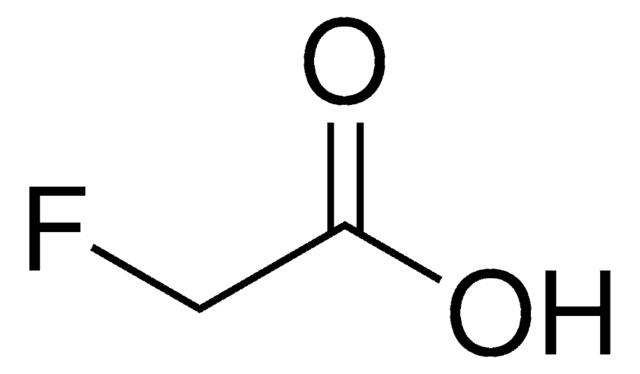All Photos(2)
About This Item
Linear Formula:
C6H5CH2CH(CH3)CO2H
CAS Number:
Molecular Weight:
164.20
MDL number:
UNSPSC Code:
12352100
PubChem Substance ID:
NACRES:
NA.22
Recommended Products
Assay
98%
form
solid
bp
167-168 °C/23 mmHg (lit.)
mp
39-41 °C (lit.)
density
1.065 g/mL at 25 °C (lit.)
functional group
carboxylic acid
phenyl
SMILES string
CC(Cc1ccccc1)C(O)=O
InChI
1S/C10H12O2/c1-8(10(11)12)7-9-5-3-2-4-6-9/h2-6,8H,7H2,1H3,(H,11,12)
InChI key
MCIIDRLDHRQKPH-UHFFFAOYSA-N
Related Categories
General description
α-Methylhydrocinnamic acid (2-methyl-3-phenylpropionic acid, 2-benzylpropionic acid) is a cinnamic acid derivative. Its synthesis by the asymmetric hydrogenation of α-methylcinnamic acid has been reported. α-Methylhydrocinnamic acid, a short chain fatty acid derivative (SCFAD), has been reported to correct the cystic fibrosis transmembrane conductance regulator (ΔF508-CFTR) defect. Conformational studies of 2-methyl-3-phenylpropionic acid has been investigated by NMR spectroscopy. The enantiomers of 2-benzylpropionic acid has been reported to be synthesized using a lipase-catalyzed resolution. (S) (+)-2-methyl-3-phenylpropionic acid participates in the synthesis of optically active (R)-5-methyl-6-phenylhexanoyl azide. L-2-Methyl-3.phenylpropionic acid has been reported to be an inhibitor of carboxypeptidase A. Polymer-supported “Evans” oxazolidinone mediated solid phase asymmetric has been employed in the synthesis of (S)-2-methyl-3-phenylpropionic acid.
Application
α-Methylhydrocinnamic acid is suitable for use in the comparative study to investigate the γ-globin inducibility of short-chain fatty acid derivatives (SCFADs) in mice. It may be used as a histone deacetylase (HDAC) inhibitor in the comparative study to investigate the EGFP-induction potency of a number of HDAC inhibitors. It may be used in the study to investigate the selectivity of the sensor based on imprinted poly(o-phenylenediamine) (iPoPD).
Signal Word
Warning
Hazard Statements
Precautionary Statements
Hazard Classifications
Eye Irrit. 2 - Skin Irrit. 2 - STOT SE 3
Target Organs
Respiratory system
Storage Class Code
11 - Combustible Solids
WGK
WGK 3
Flash Point(F)
235.4 °F - closed cup
Flash Point(C)
113 °C - closed cup
Personal Protective Equipment
dust mask type N95 (US), Eyeshields, Gloves
Choose from one of the most recent versions:
Already Own This Product?
Find documentation for the products that you have recently purchased in the Document Library.
Customers Also Viewed
Yishan Liu et al.
Journal of hazardous materials, 192(3), 1633-1640 (2011-07-29)
Microbial degradation of the chiral 2-phenylbutyric acid (2-PBA), a metabolite of surfactant linear alkylbenzene sulfonates (LAS), was investigated using both racemic and enantiomer-pure compounds together with quantitative stereoselective analyses. A pure culture of bacteria, identified as Xanthobacter flavus strain PA1
H Peng et al.
The Analyst, 126(2), 189-194 (2001-03-10)
The preparation and characterization of electrosynthesized poly(o-phenylenediamine) (iPoPD) as a molecular imprinting material were studied by an in situ quartz crystal impedance method. The changes of delta f0, delta R1, delta L1 and delta C0 suggest that the polymer film
A potent reversible inhibitor of carboxypeptidase A.
L D Byers et al.
The Journal of biological chemistry, 247(2), 606-608 (1972-01-25)
Synthesis of chiral building blocks for selective adenosine receptor agents. Lipase-catalyzed resolution of 2-benzylpropanol and 2-benzylpropionic acid.
Delinck DL and Margolin AL.
Tetrahedron Letters, 31(47), 6797-6798 (1990)
Jörgen Samuelsson et al.
Journal of chromatography. A, 1163(1-2), 177-189 (2007-07-07)
A systematic study was made to explain the large improvements in separation performance and capacity of basic compounds at alkaline conditions. The adsorption of three probe components was investigated on four alkaline-stable silica-based C18 columns at three different pH-levels: 3
Our team of scientists has experience in all areas of research including Life Science, Material Science, Chemical Synthesis, Chromatography, Analytical and many others.
Contact Technical Service










